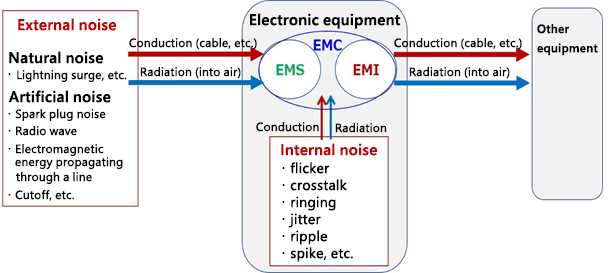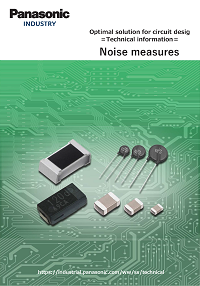Noise-reducing measures start with knowing about the different types and properties of noise.
2017-09-25
What is noise?
Noise refers to voltages, currents, signals, etc., that depart from intended voltages, currents, and signals. There are various types of noise. In many cases, therefore, the types of noise to be eliminated vary widely depending on the application or field. For example, electromagnetic wave noise causes interference that degrades communication quality, posing a problem with radio communication. Ringing noise resulting from switching operations causes problems with switching power supplies. These example show that noise, which engineers who deal with both weak and strong electric elements have to cope with in their daily work, greatly varies in voltage, current, and properties.
In addition to many types of noise, there are numerous cases where one type of noise is called by multiple names. 1/f noise, which is one of the basic noise types created by transistors, etc. is also referred to also as "flicker noise" or "pink noise." Surges and spikes are both forms of transient voltage noise. A voltage surge lasts several milliseconds, while a voltage spike lasts from nanoseconds to several microseconds. Strictly speaking, therefore, the terms "surge" and "spike" should be used to describe these different types of noise, but this precise definition is often ignored.
Noise is basically unwanted and therefore should be eliminated or reduced by noise-reducing measures if it causes a problem. Noise-reducing measures to apply, however, vary according to the properties of the noise in question. Different noise-reducing measures, therefore, should be taken against different types of noise. There are many cases in signal transmission where clearly separating the necessary signal from the noise signal is a challenge. In this case, it may be necessary to make a compromise at an allowable noise level.
Considering what has been described above, we can say that a noise-reducing measure starts with "knowing the type and properties of noise." We have summarized various types of noise below. Putting aside various opinions on how to classify noise, we have classified noise in view of their origins and ways of propagation.
Noise sources: natural noise, artificial noise, external noise, and internal noise
Tracking noise to its origins, we find two major noise sources: natural noise existing in the natural world and artificial noise created by human-made objects or phenomena.
Typical examples of natural noise are atmospheric static noise (lightning), solar noise, cosmic noise, etc.
Human-made objects powered by electricity usually emit noise. Typical examples of such objects include spark plugs, switches, and electric motors. Equipment we use in our daily life, such as microwave ovens, TV sets, PCs, and smartphones also emits electromagnetic noise.
A noise source analysis may be carried out by focusing on whether a noise source is external or internal. Whether a noise source is a natural or artificial one can be determined fairly easily. Determining whether a noise source is internal or external however, requires the point of reference to be the object affected by the noise. For this reason, an internal noise source may become an external noise source and vice versa depending on the situation. Natural noise mentioned above is usually external noise. Artificial noise, on the other hand, can be both external noise and internal noise.
For example, in the case of a TV set, a lightning surge from the AC line counts as natural external noise. In rare cases, a car passing near a TV set can cause a disturbance of its picture and sound, in which case radio waves from the car's spark plugs, etc., are creating the disturbance and are therefore treated as artificial external noise to the TV set. The TV set also houses a switching power supply, high-speed CPU, image processing LSI, etc., which emit switching noise and other noise characteristic of high-speed digital signals. These are treated as artificial internal noise. The TV set itself is immune to such noise because of the anti-noise measures incorporated in it. However, a radio brought closer to this TV set shows increasingly poor reception, and emits distorted sounds. In this case, the radio is affected by the artificial external noise emitted from the TV set.
The way noise propagates: conduction noise and radiation noise
Noise can be classified into two types: conduction noise and radiation noise.
Conduction noise propagates through power/signal cables and conductors such as thin-film wiring lines on a printed board. This noise travels along both power lines and signal lines. A power line transmits surge, ripple, and spike noise. A signal line transmits flicker (1/f), shot, and thermal noise from analog systems and crosstalk and reflection (ringing, over/undershoot, jitter) noise from digital systems.
Radiation noise is noise released (radiated) into the air. A line or cable carrying conduction noise, i.e., noise current, works as a sort of antenna which emits undesirable electromagnetic waves, that is, radiation noise.
EMC (Electromagnetic Compatibility)
Manufactured equipment is increasingly required to meet EMC standards. We will now brief you on EMC in connection with external and internal noise. EMC stands for Electromagnetic Compatibility, and refers to a piece of equipment's compatibility with the environment affected by electromagnetic waves or applicability to such an environment. It encompasses both concepts of EMI (Electromagnetic Interference) and EMS (Electromagnetic Susceptibility). Equipment having EMC thus offers both advantages of not making electromagnetic interference (EMI) and maintaining its performance even if subjected to electromagnetic interference. EMI includes conduction noise and radiation noise, and EMS requires resistance to both types of noise.
The following Figure will give you a visual impression of what we've described above.

Actual anti-noise components
Up to now we have discussed noise sources and their major types. As described above, noise-reducing measures vary depending on noise properties, and therefore different measures must be taken against different types of noise. Hence various anti-noise components are provided to deal with noise of different types and properties. Anti-noise components used to suppress various types of noise are shown below.
1) Signal noise
Phase-identical noise causing problems with differential signal data transmission, such as LVDS, is a type of conduction noise that damages signal quality. A single-end signal line is interfered with by various types of conduction and radiation noise, regardless of whether they are external or internal. To prevent noise interference with signals, the anti-noise components shown below are used for noise filtering.
2) Power supply noise
A switching-type power supply generates switching noise, such as ripples, ringing, and spikes. These forms of noise travel along the power line and reach the power supply device. Switching noise created by high voltages or high currents, on the other hand, radiates and interferes with surrounding equipment and components. To suppress this type of power supply noise, the anti-noise components shown below are used for noise filtering or cutoff.
-

Conductive Polymer Aluminum Electrolytic Capacitors
(SP-Cap) -

Conductive Polymer Tantalum Solid Capacitors
(POSCAP) -

Conductive Polymer Aluminum Solid Capacitors
(OS-CON) -

Conductive Polymer Hybrid Aluminum Electrolytic Capacitors
-

Aluminum Electrolytic Capacitors
(Surface Mount Type) -

Aluminum Electrolytic Capacitors
(Radial Lead Type) -

Film Capacitors
(Electronic Equipment Use) -

Power Inductors for Automotive application
-

Power Inductors for Consumer
3) Electromagnetic wave noise
Electromagnetic wave noise includes externally-generated natural/artificial radiation noise and internally-generated radiation noise from switching power supplies, high-speed data transmission lines, etc. To suppress electromagnetic wave noise, reducing noise radiation is necessary from the viewpoint of EMI, and providing a shield is essential from the viewpoint of EMS. The anti-noise components shown below are used in this way.
4) Electrostatic noise
Electrostatic charge that builds up on a material is released as a high-voltage current that rapidly reaches the order of kilovolt-amperes, causing malfunction of electronic equipment or damaging to electronic components. The anti-noise components shown below are specifically designed to neutralize static discharge and are therefore useful as measures against electrostatic noise.
5) Surges
Lightning surges are known as ordinary power surges. In in-vehicle equipment, load dump pulses caused by cutting off the power supply from the battery can pose a problem. Because a power surge carries high energy, a specific anti-noise component designed for surge suppression should be used as a countermeasure.
Panasonic offers a wide lineup of anti-noise components that deal with various types of noise.







